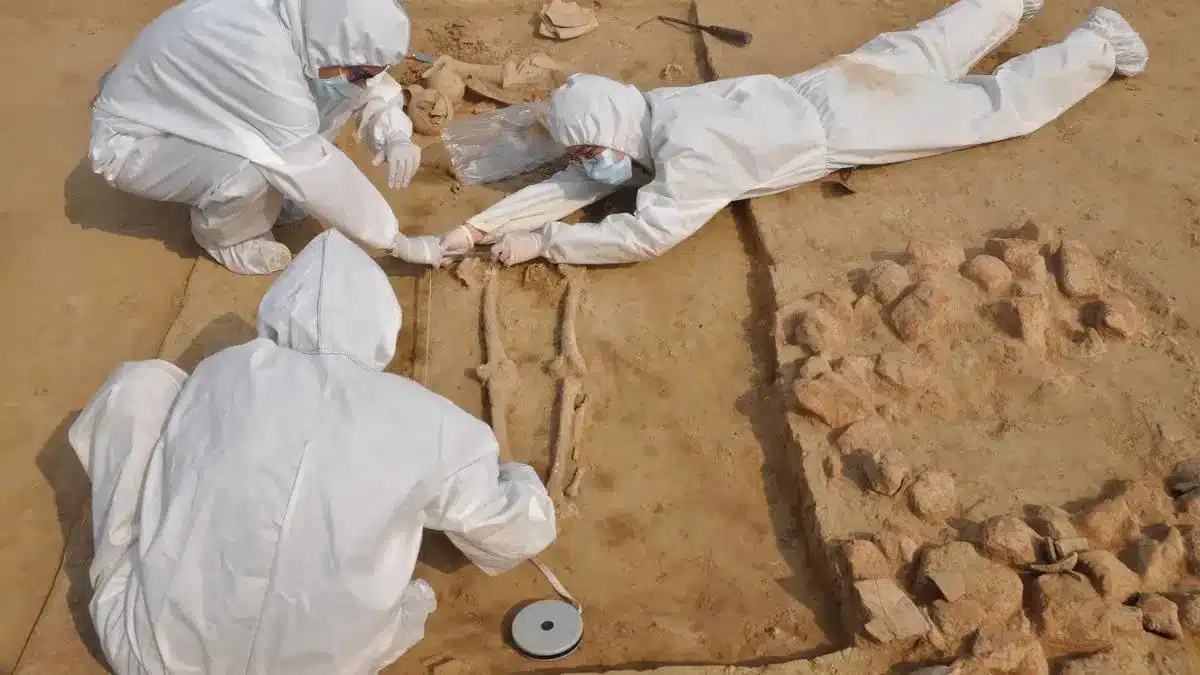What’s in today’s article?
- Why in News?
- Indus Valley Civilisation (IVC)/ Harappa Civilisation (3300 – 1300 BCE)
- The Vedic Age (1500 – 600 BCE)
- How Archaeologists are Establishing Relationships Between the Harappan and the Vedic Age?
Why in News?
- Archaeologists are working with Sanskrit scholars to decipher the Rigveda, carrying on research that could lead to a relationship between the people of the Vedic age and the Harappan civilization.
Indus Valley Civilisation (IVC)/ Harappa Civilisation (3300 – 1300 BCE):
- Also known as the Indus Civilisation, the IVC was a Bronze Age civilisation in the northwestern regions of South Asia.
- The Indus civilisation is also known as the Harappan Civilisation, after Harappa (now in Punjab), which is the first of its sites to be excavated early in the 20th century.
- Together with ancient Egypt and Mesopotamia, it was one of three early civilisations of the Near East and South Asia, and the most widespread among the three.
- Its sites stretch over an area spanning from today’s northeast Afghanistan, through much of Pakistan and into western and northwestern India.
- It flourished in the basins of the Indus River and along a system of rivers that once coursed in the vicinity of the seasonal Ghaggar-Hakra river in northwest India and eastern Pakistan.
- The civilisation’s cities were noted for their –
- Urban planning,
- Baked brick houses,
- Elaborate drainage systems,
- Water supply systems,
- Clusters of large non-residential buildings,
- New techniques in handicraft (carnelian products, seal carving) and
- Metallurgy (copper, bronze, lead and tin).
- The urbanisation that accompanied the civilisation may have started as a result of the region’s soil gradually drying out during the third millennium BCE.
- However, the civilisation eventually declined and its population dispersed eastward and southward due to weaker monsoons and a lower water supply.
The Vedic Age (1500 – 600 BCE):
- It is the period in the late Bronze Age and early Iron Age of the history of India when the Vedic literature, including the Vedas was composed in the northern Indian subcontinent.
- It lies between the end of the urban IVC and the second urbanisation, which began in the central Indo-Gangetic Plain (c. 600 BCE).
- In terms of literature, as well as social and cultural evolution, Vedic age is divided into two stages
- The Rigvedic period/ Early Vedic period (between 1500 BC and 1000 BC) and
- The Later Vedic period (between 1000 BC and 600 BC).
- The early Vedic Aryans lived in the area known as sapta-sindhu/ an area of seven rivers – in and around present-day Punjab region.
- During the Later Vedic period, they gradually moved eastward and came to occupy eastern UP (Kosala) and north Bihar (Videha).
How Archaeologists are Establishing Relationships Between the Harappan and the Vedic Age?
- Ongoing debates:
- The NCERT recently made a major addition (based on DNA evidence from the 4,600-year-old remains of a woman) to the Class 12 History textbook, indicating that the Harappans were an indigenous people.
- The NCERT has added a disclaimer that more research is required to establish this relationship.
- Some historians believe that the Vedas date farther back to 2,500 BC/ 4,500 years ago, which would coincide with the IVC.
- The NCERT recently made a major addition (based on DNA evidence from the 4,600-year-old remains of a woman) to the Class 12 History textbook, indicating that the Harappans were an indigenous people.
- What archaeologists are trying to establish?
- Archaeologists are now working to test the hypothesis that the Harappans and the Vedic people were the same.
- According to the renowned archaeologist Vasant Shinde, a clear understanding of what is mentioned in the Rigveda text is importantto co-relate archaeological evidence unearthed in excavations of Harappan settlements.
- What evidence shows?
- While excavating the site of Rakhigarhi (Haryana), the archaeologists found evidence of ritual platforms and fire altars. Fire worship is also mentioned in Rig Vedic texts.
- The mention of the river Saraswati (modern Ghagghar-Hakra river) is recorded at least 71 times in the Rigvedic text. During archaeological excavations, a majority of Harappan settlements were discovered along the banks of river Saraswati.
- Another point of reference which may link the Harappans with Vedic times is a set of animal bones found and studied by archaeo-zoologists in the Surkotada region of Kutch, Gujarat.
- While some researchers stated that these bones belonged to a proper domesticated horse (which finds mention in Rigvedic texts), another group concluded that these were the bones of a wild ass.
Q.1. What is the significance of the Harappan site of Dholavira?
Located on the Tropic of Cancer, Dholavira is one of the five largest Harappan sites and most prominent archaeological sites in India belonging to the Indus Valley Civilization. It is also considered as having been the grandest of cities of its time.
Q.2. What were the Mahajanpadas in ancient India?
The Mahajanpadas were sixteen kingdoms and aristocratic republics that existed in ancient India from the sixth to fourth centuries BCE, during the second urbanisation period.
Source: Archaeologists, Sanskrit scholars tie up to decipher Rigveda text
Last updated on December, 2025
→ Check out the latest UPSC Syllabus 2026 here.
→ Join Vajiram & Ravi’s Interview Guidance Programme for expert help to crack your final UPSC stage.
→ UPSC Mains Result 2025 is now out.
→ UPSC Notification 2026 is scheduled to be released on January 14, 2026.
→ UPSC Calendar 2026 is released on 15th May, 2025.
→ The UPSC Vacancy 2025 were released 1129, out of which 979 were for UPSC CSE and remaining 150 are for UPSC IFoS.
→ UPSC Prelims 2026 will be conducted on 24th May, 2026 & UPSC Mains 2026 will be conducted on 21st August 2026.
→ The UPSC Selection Process is of 3 stages-Prelims, Mains and Interview.
→ UPSC Result 2024 is released with latest UPSC Marksheet 2024. Check Now!
→ UPSC Prelims Result 2025 is out now for the CSE held on 25 May 2025.
→ UPSC Toppers List 2024 is released now. Shakti Dubey is UPSC AIR 1 2024 Topper.
→ UPSC Prelims Question Paper 2025 and Unofficial Prelims Answer Key 2025 are available now.
→ UPSC Mains Question Paper 2025 is out for Essay, GS 1, 2, 3 & GS 4.
→ UPSC Mains Indian Language Question Paper 2025 is now out.
→ UPSC Mains Optional Question Paper 2025 is now out.
→ Also check Best IAS Coaching in Delhi



















